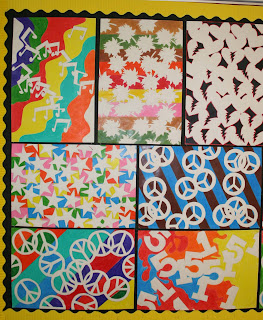 |
| Colored Pencil Version by Madison 1 point perspective assignment |
Teaching 1 Point Perspective
High School Art
This lesson is a refresher lesson for my 2nd year Art students. I teach 2 point linear perspective in beginning Art. It seems backwards, but I found that teaching 2 point perspective step by step in Art 1, teaches them the basics of perspective with good results. In the fall of 2nd year Art I use this Room Project with my Art 2 students using 1 point perspective. This project shows the students how perspective can be applied to drawing everyday objects.
Supplies Needed: (+ a few tips)
Drawing Pencils
Erasers
Sketchbook
Clear T-square
+Tip: I like the clear, so they can see their
previously drawn lines.
 Colored Pencil Classpack:
Colored Pencil Classpack:
 +Tip: I like to use the classpack because it becomes the student's responsibility to return their colored pencils back to the correct spot in the box, which helped eliminate the misplaced colors. When using individual boxes, all of the colors did not seem to stay in each box.
+Tip: I like to use the classpack because it becomes the student's responsibility to return their colored pencils back to the correct spot in the box, which helped eliminate the misplaced colors. When using individual boxes, all of the colors did not seem to stay in each box.
Drawing Assignment
Their assignment is to include:
-At least one door
-At least one window
-2 pieces of furniture
-A wall decoration
-A floor decoration (tile, rug, wood floor, etc)
-A ceiling fixture (lighting, etc).
Step 1: They were introduced to 1 and 2 pt. perspective in Art 1, so they have some experience with the linear perspective techniques. But even with that experience, they must have a little refresher assignment. I demonstrate to them how to change 9 squares into 9 cubes to by using 1 vanishing point in the center of the page. This can be done any way you choose to teach one point perspective.
Step 2: After they practice that assignment, where I also teach them to use a T-square, they start drawing their rooms. I show them samples of rooms drawn by former students, to get ideas for types of rooms, furnishings, and other ideas that they could create.
Step 3: Students use their sketchbook to sketch ideas and to practice drawing difficult details.
Step 4: Students transfer their ideas onto the final drawing paper, being careful to draw with a light touch. Many lines will be erased, so drawing lightly is important. Heavy lines are difficult, if not impossible, to erase. Check perspective before proceeding to Step 5.
Step 5: Add color or value to the drawing.
Sometimes I give them a choice between using colored pencils or just to use pencils to add shading to their drawings to create a value study with their graphite pencils. Some students are better with pencils and some are better with color. One thing we need to work on is adding values with the colored pencils. That is a little difficult to do with student grade colored pencils.
High School Art
This lesson is a refresher lesson for my 2nd year Art students. I teach 2 point linear perspective in beginning Art. It seems backwards, but I found that teaching 2 point perspective step by step in Art 1, teaches them the basics of perspective with good results. In the fall of 2nd year Art I use this Room Project with my Art 2 students using 1 point perspective. This project shows the students how perspective can be applied to drawing everyday objects.
Supplies Needed: (+ a few tips)
Drawing Pencils
Erasers
Sketchbook
Clear T-square
+Tip: I like the clear, so they can see their
previously drawn lines.
Drawing Assignment
Their assignment is to include:
-At least one door
-At least one window
-2 pieces of furniture
-A wall decoration
-A floor decoration (tile, rug, wood floor, etc)
-A ceiling fixture (lighting, etc).
Step 1: They were introduced to 1 and 2 pt. perspective in Art 1, so they have some experience with the linear perspective techniques. But even with that experience, they must have a little refresher assignment. I demonstrate to them how to change 9 squares into 9 cubes to by using 1 vanishing point in the center of the page. This can be done any way you choose to teach one point perspective.
Step 2: After they practice that assignment, where I also teach them to use a T-square, they start drawing their rooms. I show them samples of rooms drawn by former students, to get ideas for types of rooms, furnishings, and other ideas that they could create.
Step 3: Students use their sketchbook to sketch ideas and to practice drawing difficult details.
Step 4: Students transfer their ideas onto the final drawing paper, being careful to draw with a light touch. Many lines will be erased, so drawing lightly is important. Heavy lines are difficult, if not impossible, to erase. Check perspective before proceeding to Step 5.
Step 5: Add color or value to the drawing.
Sometimes I give them a choice between using colored pencils or just to use pencils to add shading to their drawings to create a value study with their graphite pencils. Some students are better with pencils and some are better with color. One thing we need to work on is adding values with the colored pencils. That is a little difficult to do with student grade colored pencils.
So here are some of the results from the assignment with both the value studies and colored pencils.
 |
| Colored Pencil |
 |
| Graphite Pencils |
Mrs. Macre♥Art
















































